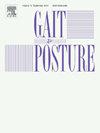Exploring the role of reduced optic flow in dynamic balance
IF 2.2
3区 医学
Q3 NEUROSCIENCES
引用次数: 0
Abstract
Introduction
When optic flow-related visual feedback is reduced to zero (no scene motion with head motion), the amplitude of postural sway increases. However, there is limited work examining the amount of optic flow required to maintain stable (or baseline) amplitudes of postural sway, especially during dynamic stance tasks where there is an increased reliance on visual cues.
Objectives
The objective of the present study was to examine optic flow during dynamic stance and determine the amount of optic flow required before postural sway deviates from conditions with a gain of 1.
Methods
Twenty-six healthy adults stood on a force plate (used to calculate Centre of Pressure; COP) mounted to a motorized platform that pseudo-randomly translated continuously in the anteroposterior direction ( ± 5 cm, 0–1 Hz) for 60-s. Participants wore a virtual reality head-mounted display, used to show a virtual environment and assess head position (HeadPos). Optic flow-related visual feedback was reduced relative to head motion (0–1 in 0.25x increments). Amplitude and mean power (MP for four bands: LOW, 0–0.1 Hz; MED, 0.1–0.5 Hz; MED-HIGH, 0.5–1 Hz; HIGH, 1–5 Hz) of COP and HeadPos was used to quantify movement.
Results
COP and HeadPos amplitude, and MED-MP increased when optic flow gain was less than 0.5x.
Conclusions
Therefore, half the amount of optic flow-related visual feedback is enough to sustain levels of postural sway observed in real-world conditions (gain of 1). Visual contributions to dynamic balance control likely extend beyond previously theorized frequencies (<0.1 Hz in quiet stance), signifying the importance of vision during complex postural tasks.
求助全文
约1分钟内获得全文
求助全文
来源期刊

Gait & posture
医学-神经科学
CiteScore
4.70
自引率
12.50%
发文量
616
审稿时长
6 months
期刊介绍:
Gait & Posture is a vehicle for the publication of up-to-date basic and clinical research on all aspects of locomotion and balance.
The topics covered include: Techniques for the measurement of gait and posture, and the standardization of results presentation; Studies of normal and pathological gait; Treatment of gait and postural abnormalities; Biomechanical and theoretical approaches to gait and posture; Mathematical models of joint and muscle mechanics; Neurological and musculoskeletal function in gait and posture; The evolution of upright posture and bipedal locomotion; Adaptations of carrying loads, walking on uneven surfaces, climbing stairs etc; spinal biomechanics only if they are directly related to gait and/or posture and are of general interest to our readers; The effect of aging and development on gait and posture; Psychological and cultural aspects of gait; Patient education.
 求助内容:
求助内容: 应助结果提醒方式:
应助结果提醒方式:


